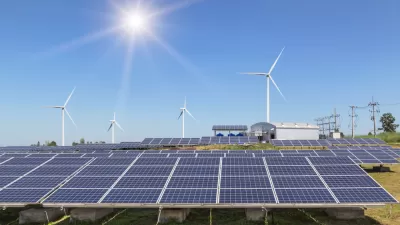Talk about bringing power to the people: eight regional governments in California are in various stages of adopting "community choice" utilities to buy power from the grid in the hopes of cleaning up their energy portfolio.
"From Silicon Valley to the East Bay to the Central Coast, a "people's power" movement is sweeping through California that will give local residents a choice to ditch PG&E and buy cleaner -- and possibly cheaper -- energy from the cities and counties where they live," reports Tracy Seipel.
Specifically, Seipel is referring to "community choice" utilities, currently place in three counties around the state but under consideration for many more. Seipel explains more about how the community choice utilities operate:
"Overseen by a team of energy experts and a board of elected officials, new community-run utilities are buying power from the grid, procuring a higher percentage of renewable energy -- think solar and wind, as well as methane from dairy cows -- than PG&E, while aiming for a price around or even below the giant utility's rates. The new power systems also are charged with developing more local renewable energy."
Seipel also sums up the political debate surrounding the idea, noting that critics of the arrangement call community choice "a feel-good solution that will lead to unstable prices, empty promises and -- at least for the time being -- no additional green energy."
The remainder of the article focuses on the fortunes of the community choice utilities so far, as well as insight into the slightly esoteric but still critical matter of the "exit fee" that determines how expensive the model is in any given month.
FULL STORY: Bay Area communities gearing up to create their own power systems

Alabama: Trump Terminates Settlements for Black Communities Harmed By Raw Sewage
Trump deemed the landmark civil rights agreement “illegal DEI and environmental justice policy.”

Planetizen Federal Action Tracker
A weekly monitor of how Trump’s orders and actions are impacting planners and planning in America.

The 120 Year Old Tiny Home Villages That Sheltered San Francisco’s Earthquake Refugees
More than a century ago, San Francisco mobilized to house thousands of residents displaced by the 1906 earthquake. Could their strategy offer a model for the present?

Indy Neighborhood Group Builds Temporary Multi-Use Path
Community members, aided in part by funding from the city, repurposed a vehicle lane to create a protected bike and pedestrian path for the summer season.

Congestion Pricing Drops Holland Tunnel Delays by 65 Percent
New York City’s contentious tolling program has yielded improved traffic and roughly $100 million in revenue for the MTA.

In Both Crashes and Crime, Public Transportation is Far Safer than Driving
Contrary to popular assumptions, public transportation has far lower crash and crime rates than automobile travel. For safer communities, improve and encourage transit travel.
Urban Design for Planners 1: Software Tools
This six-course series explores essential urban design concepts using open source software and equips planners with the tools they need to participate fully in the urban design process.
Planning for Universal Design
Learn the tools for implementing Universal Design in planning regulations.
Clanton & Associates, Inc.
Jessamine County Fiscal Court
Institute for Housing and Urban Development Studies (IHS)
City of Grandview
Harvard GSD Executive Education
Toledo-Lucas County Plan Commissions
Salt Lake City
NYU Wagner Graduate School of Public Service





























